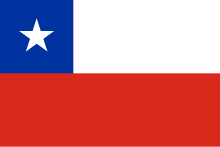This article has multiple issues. Please help improve it or discuss these issues on the talk page. (Learn how and when to remove these template messages)
|
 The flag of Chile | |
| Data | |
|---|---|
| Water coverage (broad definition) | (improved water source) 96% (2010)[1] |
| Sanitation coverage (broad definition) | (improved sanitation) 96% (2010)[1] |
| Share of collected wastewater treated | 82% (2006)[2] |
| Continuity of supply | 100%[2] |
| Average urban water use (L/person/day) | 196 (2006)[2] |
| Average urban water and sanitation tariff (US$/m3) | n/a |
| Share of household metering | 96% (2006)[2] |
| Annual investment in WSS | US$23.1/capita (2006)[2] |
| Share of self-financing by utilities | High |
| Share of tax-financing | n/a |
| Share of external financing | Low |
| Institutions | |
| Decentralization to municipalities | No, central government regulation |
| National water and sanitation company | None |
| Water and sanitation regulator | Yes |
| Responsibility for policy setting | Ministry of Public Works |
| Sector law | Yes (1988, amended in 1998) |
| No. of urban service providers | 20 |
| No. of rural service providers | n/a |
Water supply and sanitation in Chile were once considered efficient and equitable but in 2022 Chile struggled to reliably provide water throughout the country.[3][4] Chile's water resources have been strained by the Chilean water crisis, which was partially caused by a continuing megadrought that began in 2010,[5] along with an increased demand for agricultural and other commercial interests.[6]
Chile began rationing water in April 2022.[7] Chile's water and sanitation sector distinguishes itself in a few key ways. First, all urban water companies are privately owned or operated (the only exception is SMAPA), and water was defined as a private commodity in the 1980 Constitution of Chile. Second, the Chilean government instituted a subsidy for water costs in 1990 for citizens located in impoverished regions.[8] Third, Chile became the first Latin American Country to achieve 100% of its population using basic water sanitation in 2016.[9]
- ^ a b Cite error: The named reference
JMP1was invoked but never defined (see the help page). - ^ a b c d e Superintendencia de Servicios Sanitarios (SISS) (2007). "Informe de gestión del sector sanitario 2006" (in Spanish). Retrieved 2008-02-13. pgs. 28-96
- ^ Alvarado, Ivan (2022). "'We beg God for water': Chilean lake turns to desert, sounding climate change alarm". Reuters. Retrieved 2022-08-30.
- ^ NASA (2016). "A Strained Water System in Chile". Retrieved 2022-08-30.
- ^ Garreau, René D.; Boisier, Juan P. (2019). "The Central Chile Mega Drought (2010–2018): A climate dynamics perspective". International Journal of Climatology. 40 (1): 421–439. doi:10.1002/joc.6219. S2CID 198413538. Retrieved 2022-08-30.
- ^ Lozano Parra, Javier; Pulido Fernández, Manuel; Garrido Velarde, Jacinto (2021). "The Availability of Water in Chile: A Regional View from a Geographical Perspective". Resources of Water. intechopen. doi:10.1002/joc.6219. ISBN 978-1-83881-912-5. S2CID 198413538. Retrieved 2022-08-30.
- ^ "Chile announces unprecedented water rationing plan as drought enters 13th year". Reuters. 2022. Retrieved 2022-08-30.
- ^ Palma, Isidora; Gómez-Lobo, Andrés; Contreras, Dante (2018). "Revisiting the distributional impacts of water subsidy policy in Chile: A historical analysis from 1998–2015". Water Policy. 20 (6): 1208–1226. doi:10.2166/wp.2018.073. S2CID 158194967.
- ^ World Health Organization (2022). "Population using at least basic sanitation services". Retrieved 2022-09-01.